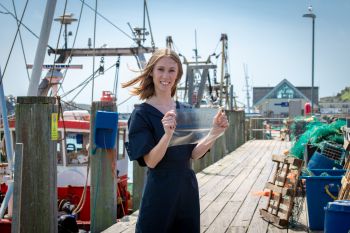Scale of the problem: How fish skins and algae could help solve the plastic pollution crisis
By:
Last updated: Wednesday, 12 June 2019

Product design student Lucy Hughes has invented a bioplastic created from fish skin and scales and red algae

A University of Sussex student has taken inspiration from the seas to find a solution to the man-made plastic pollution contaminating the world’s oceans.
Product design student Lucy Hughes has invented a bioplastic created from fish skin and scales and red algae which could have a huge impact on limiting the amount of non-biodegradable plastic waste created in the world.
The fully biodegradable and compostable material, called Marinatex, has been designed as an environmentally-responsible replacement for plastic film currently used in a whole host of packaging including sandwich boxes.
It can biodegrade in a soil environment in less than a month and can be disposed of through ordinary food waste collections.
Lucy, a fourth year product design undergraduate student at the University of Sussex, said: "It makes no sense to me that we are using plastic, an incredibly durable material, for products that have a lifecycle of less than a day. And I'm not alone, there is a growing community of bioplastic pioneers that are working towards finding alternatives to our dependency on plastic.
“With Marinatex, we are transforming a waste stream into the main component of a new product. By doing so, we have created a consistent, transparent and 'plastic-like' material with a more planet friendly and product appropriate lifecycle for packaging."
The 23-year-old student from Twickenham developed her idea following a visit to Newhaven-based sustainable fishing company MCB Seafoods Ltd.
Seeing first-hand the organic waste material from the fishing industry, she identified the potential in the material, in reliable and plentiful supply, which when combined with a biopolymer such as red algae created an extremely effective plastic substitute.
Lucy said: “Algae bioplastics are becoming more common, but the issue I faced during development was that the sheets I made without the fish waste seemed to revert back into a crinkled seaweed shape. I needed to find a material that would make the formula more consistent. I challenged myself to find a material that was from a local waste stream. My initial experiments involved other types of fish waste such as mussel shells and crustacean skeletons before settling on fish waste. The result was a locally sourced sea-based solution."
A recent study has revealed that some bioplastics, such as PLA made from fermented corn starch, have not lived up to claims of being compostable or biodegradable – remaining intact after more than three years.
Marinatex degrades in a tiny fraction of that time, and is also cheaper to produce and does not require an entirely new recycling scheme for disposal.
The newly-developed material is also stronger than a standard plastic bag and does not leach toxins into the natural environment.
The material was developed as part of Lucy’s undergraduate product design degree at the University of Sussex but she is keen to develop the idea further.
While further testing and scaling up of the business need to be explored, she is optimistic that with right support the product could be ready for the market in little over a year.

